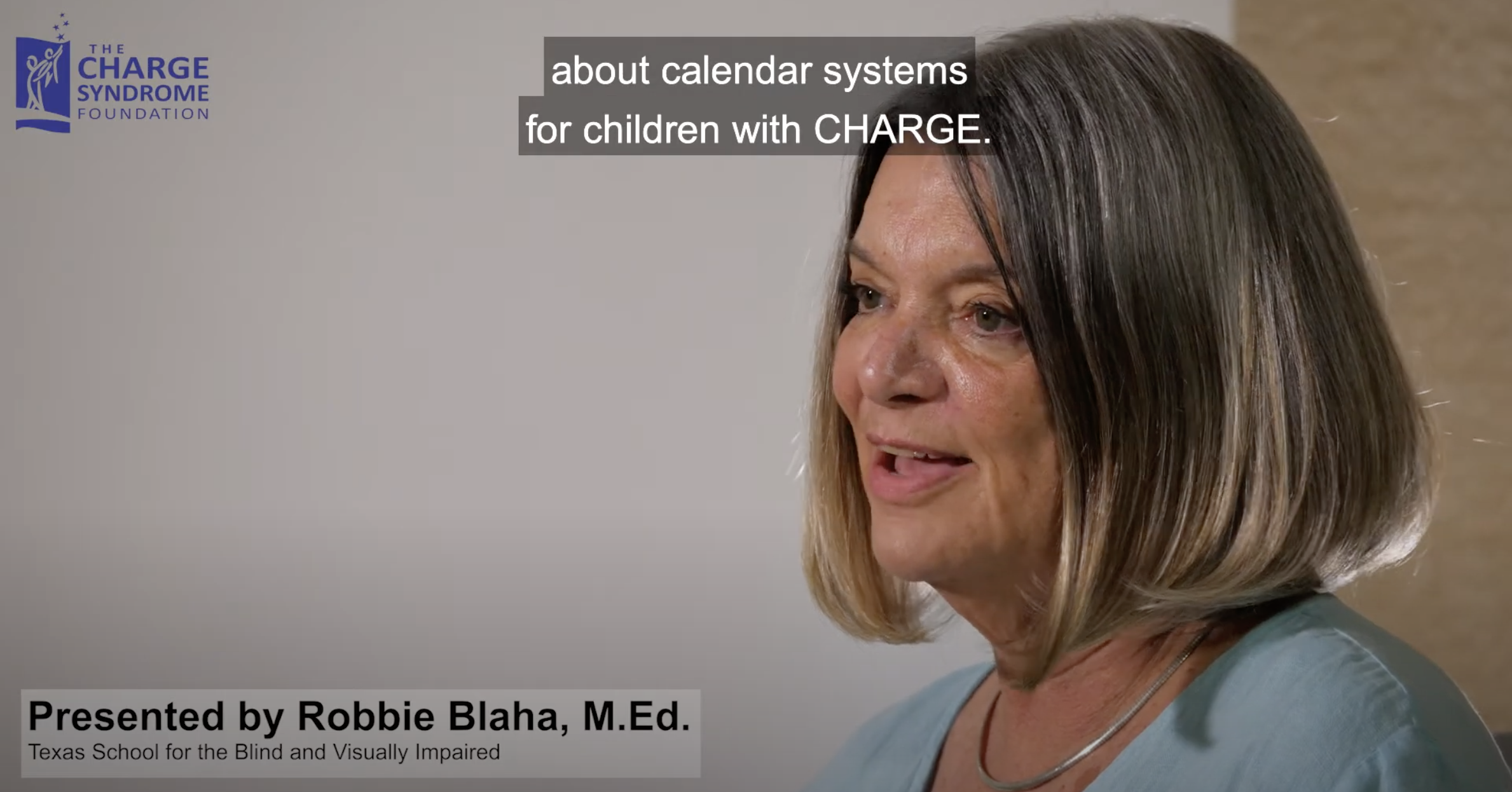
Robbie Blaha Discusses Calendar Systems for Children with CHARGE Syndrome
Robbie Blaha presents a video on Calendar Systems for the CHARGE Syndrome Foundation.
Deafblind Specialist Robbie Blaha from the Texas School for the Blind and Visually Impaired (TSBVI) presents a 27-minute video about Calendar Systems for the CHARGE Syndrome Foundation Speaker Series.
Transcript
Rather than schedules, I like to think about calendar systems right for children with CHARGE. Dr. Jan van Dijk was the person who first introduced the strategy of using calendar systems with children and at first people were thinking, “a calendar?” I mean I have a calendar in my kitchen, you know, I’ve got a calendar in my purse, but how would I give a calendar to a child who isn’t reading or isn’t communicating? So how would you use a calendar with a kid like that?
Designing Timepieces for Children Who Don’t Use a Traditional Format
And so one of the things I really respected about Dr. van Dijk is he developed a way to design timepieces for children who couldn’t use a traditional format and really, when you think about a timepiece, they’re just kind of a series of chunks like a piece of paper that’s kind of divided into a grid, you know, with seven across and what, maybe five down? I mean it’s a monthly calendar, but it’s a series of chunks of time discrete areas that represent a segment of time and he took that and he developed time pieces for children that were more concrete like a box, you know, a long box.
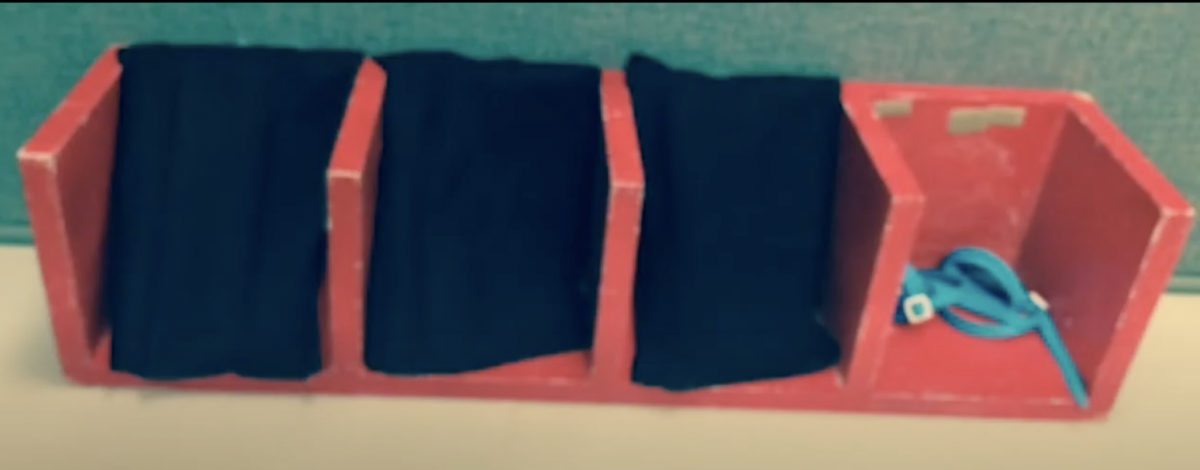
What do timepieces have in common?
Some of the things that timepieces have in common are that they are tangible. They have tangible sections; they represent that individual child’s time concepts and time needs because for some children their future is the next activity and that’s as far into the future as they’re thinking. And some children go to bed at night wondering if their grandmother’s going to be there in the morning or if they wake up in the morning and wonder if they’re going to go swimming that afternoon. So their timeframe is really more of a day. So all children have a timeframe that they’re currently functioning in and you need a timepiece that represents that to them so you can discuss with them the segments or activities that are going to be happening to them and in what order which — that’s very important — the order or sequence that their day is going to unfold.
What should you think about while developing an individualized timepiece?
One of the most important aspects of developing a calendar is deciding on your timepiece and they need to be very individual. The last thing you want to do is walk in a classroom and have four very different kids with deafblindness and four identical calendars because there’s no way that all of those kids have the same timeframe necessarily or that all of the kids like red the best because some of those kids are purple kids and some like yellow and some kids like patterns and some kids don’t like to touch plain wood. They want something soft, so they want something lined so they don’t encounter any rough edges. So it’s physically attractive to the kids or in terms of their sensory system the timepiece is attractive and manageable and so they’re very individual. So an individualized timepiece is a very important step on developing a calendar system.
What else is important when developing a calendar system?
Another important piece of developing a calendar system beyond the timepiece is having a communication system already set up with the child that’s meaningful for that kid. Some of the children use objects to represent the next activity, like if they’re going to be cooking and they absolutely love metal spoons because they bang so well or they’re always cold when you pick them up because they’re metal, you have a metal spoon to represent cooking. You have objects that from that child’s perspective represent things, so we have object kids so the calendar will use objects.
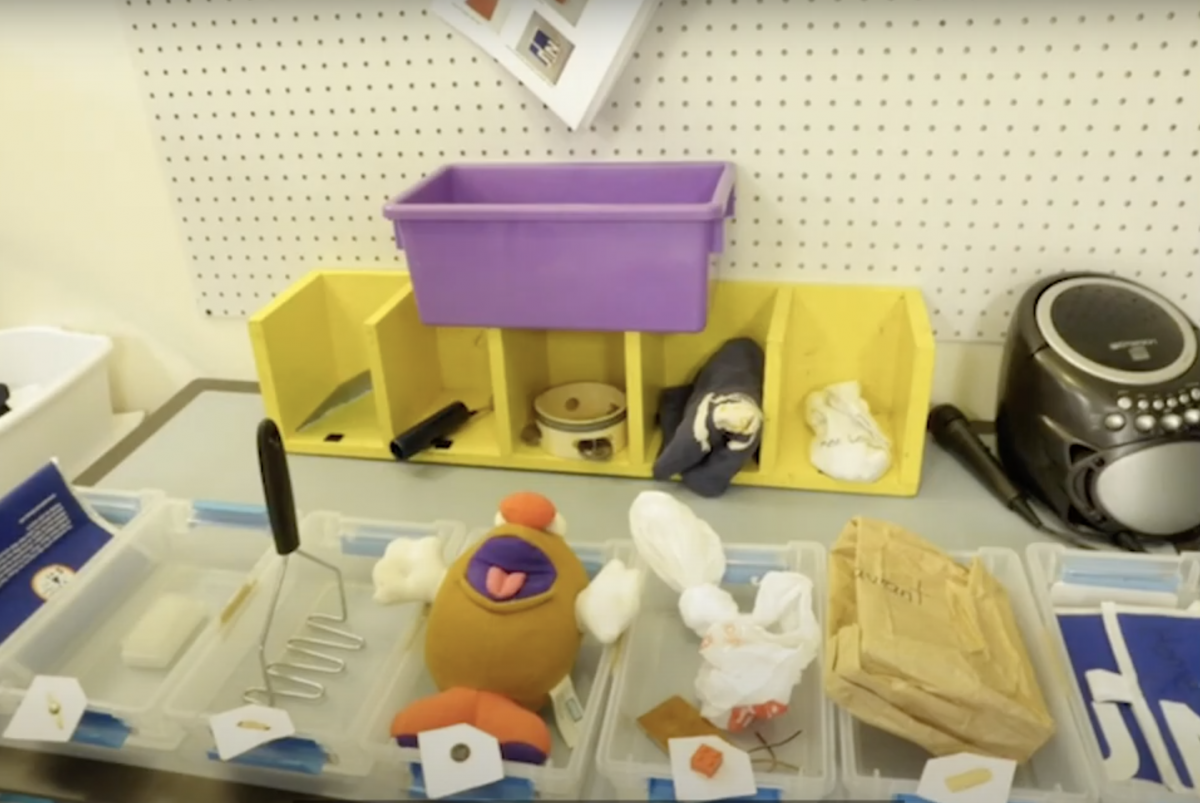
Some of our kids use parts of objects because they can be a little more abstract. Some kids use pictures, photographs, different things. So you have a tangible system of communicating even with braille pieces of paper. Every calendar system will incorporate that child’s communication. It’s really important to have that communication system in place before you even think about designing a calendar system because you really need a way to trade information with the child, so that’s a priority. Once that’s done then you can start thinking about ways to use it and the calendar system is a great way to use it.
Why is a calendar system important for someone with CHARGE?
The reason I think about calendar systems maybe even more than schedules is that calendar systems are really critical for human beings. I think it’s really interesting: you can go to any point in time or any culture and they had a way to represent time and talk about time. Because I think there’s just an innate human need to know what is going to happen to you next and a way to strike a bargain with other people about when things are going to happen so everybody’s clear on when that’s going to occur and you need a uniform time system to do that. And so I think having a calendar system really is essential for children with CHARGE because all human beings need a calendar system. It goes without saying that children with CHARGE must have one as well.
I think that one of the reasons human beings use calendar systems is to be able to have the security of knowing what’s going to happen in their future. I think not only is it important for a sense of security and control, but I think it’s very tied into hope and happiness. And I think it’s very much a mental health issue of having some security and control over your future. And having a calendar lets you know what’s coming up and when. It also gives you an opportunity to schedule some of your own things in some of those slots, to put your heart’s desire in there, and have something to look forward to. It helps you kind of get through stuff you don’t want to do because you know okay, I really don’t want to go to gym today, but after gym I get to have popcorn. I get to have popcorn or I get to play with a friend, so it’s a way to kind of negotiate your way through the day and everybody needs that or we would get nothing done.
What is it about children with CHARGE that makes a calendar system particularly helpful?

Well, all human beings need timepieces and need a way to anticipate and organize the future. I think it’s essential for children with CHARGE Syndrome to have this because they have trouble accessing information from the environment. Sometimes they miss cues that other people pick up that things are going to happen and this is a way of kind of making a contract with the child about what their great day is going to be like and to honor it and I think that if they have a calendar that they can go check and verify that it does is going to do a lot to reduce anxiety.
How does “wait” mean “yes”?
Another way I think calendars are really helpful for children with CHARGE Syndrome, I think a real emotional experience is involved with the effort of waiting. I think waiting is hard for everybody. I think that’s why on telephones they play music for us because we can’t wait. You know it kind of keeps us on the phone and pacifies us and on our computers a little line goes across the bottom to let it know that yeah, it’s about to start and I think that shows how much neurologically we need help waiting and it’s certainly going to be true for children with CHARGE Syndrome.
I think waiting is a skill that has to be taught and I think one thing that calendars help do is teach them that the word “wait” means “yes”. If they are concerned about when are they going to go swing, I think if it’s scheduled in their calendar you can take them over to the calendar and say “You’re talking about swinging. Yes!” You verify you’ve understood and the fact that you take the time to talk to them about it, they need that time to process the information and de-escalate. And I think just saying, “We’re going to talk about this so that you feel wonderful”. And to go to the calendar and say, “Yes! You are swinging.” And it waits to give something positive to that term because these kids are told all the time “you need to wait you, need to wait”. And it may sound like “no” and waiting — we can’t wait, as you know, adults — mature adults. We can’t wait without computer lights and music on the phone and they need to help wait and if you validate, “I understand. Yes, it’s going to happen.”
And with the calendar, that’s a promise. It’s extremely reassuring and you can even show them “you’re right here on your calendar and we’re going to do this and this and then you swing. Yes!” You can show them how long they’re waiting and it also, as a teacher or parent, it gives you a sense of this how much can they wait. It’s a neurological and an emotional thing and you have to build it like a muscle, learning to wait. And I’ve met kids that they can wait till the next activity, but they can’t wait five. They cannot do it, so i will move it and say, “You’re doing it next”. And in the current activity I will do it faster than it’s ever been done before and assure them every step of the way “We’re almost done and we’re waiting for the swing and you put that there. Thank you because we’re waiting for the swing.” I will get them through it emotionally and get them to the point they can do it, so that word helps. And i have seen it countless times that, when they get it, you say “wait” they it it starts the de-escalation and calming. And I think the calendar is a tangible way to convey a very abstract concept and I think it does quite a bit for anxiety and for hope.
How does a calendar system help the child understand both predictability and change?
I think one of the definite benefits calendar is that it does provide a sense of predictability in their future and their current environment. If everything is scheduled and stays the same, they feel safe and if something can’t stay the same because stuff never stays the same day in and day, day out, week in and week out, at school or home. It helps them deal with change because you can show them out of the four activities we have scheduled, all of these are the same except this one. And this one we’re going to change. We need to make a change and having that word is important because it tells them — what you want them to understand about change is that it’s limited to this specific activity. Their whole day is not in chaos and sometimes when one thing changes, I think they think their whole day’s up for grabs. So using a calendar to teach that one thing has changed helps them understand the extent of novelty they’re going to be dealing with the limits of it and then you can discuss it that this is going out, it’s changed, but something else is going to come in that you like. And this is what change is. And giving them the sign or the word is important, so that what you want is eventually when you sit down and tell your child, “We have a change”, you’ve got some time in there where they’re calm and waiting and waiting is a different emotional state. It’s a good one to be curious and kind of “I’ll give you five seconds to tell me what it is” than to have them arrive and find something different. I think you have to prepare for change. We all do and I think they absolutely have to and the calendar helps with predictability. Whether things stay the same or whether they don’t, you’ve got a strategy to deal with it.
How does a calendar system help with the concepts of past and future?
Another thing that’s really cool about calendar systems is not only does it help the child with the future, it allows the child to have a past. I think reminiscing is incredibly important to people. I don’t think we enjoy anything as much as sitting down with our cousins and going, “Do you remember this?” and just the pleasure of exchanging things in the past or sharing things because the past is never past. It is always with us and a calendar system — I just love them because I could teach them the word for “past” and usually you start with “finished” because that’s the first past past word you learn that something’s finished.
It’s now moving into the past and then “passed” which implies something a little further than just one activity, but so when you teach the calendar you also discuss, “Well, this is in the past. This morning we got up, we brushed our teeth, and do you remember I dropped your toothbrush and it got the floor dirty? I’m so sorry!” That’s in the past, but you then you talk them through a little reminiscing, so when they start the calendar in the morning it just says “toothbrush”, but when you review it — always review it because then you reminisce about something that happened and what that does that van Dyke stressed is that it it moves them out of forever living in the present.
They can discuss their future and they can discuss their past and they are free now to move about in time. They are not forever stuck in the present and I love calendars for that because I could take little things that happened, like we, you know, maybe we ran out of toothpaste or maybe I dropped it on the floor or whatever I did. I can save. I can take a picture of the dirty carpet and save it as something that happened in the past and have a little “past” box and we pull out we reminisce about things that have happened in the past.
Making Remnant Books or Memory Boxes
Van Dyke talked about making remnant books, like if you go up to a restaurant you might save the napkin, and you might save the menu or you might save some things — the little ketchup container — but you save things from the past and you can keep them in a box and they’re like memory boxes or you can put them in a little book and you can discuss the past and it helps them reminisce and the calendar teaches past and present. It teaches the vocabulary and it teaches the flow of the day or some kids a weekly calendar the flow of the week.
So some kids will be reminiscing way in the past and some kids will just be reminiscing from when they brushed their teeth that morning, but you’re giving them the opportunity to have a past and to reminisce. This is critical for human beings and difficult for CHARGE kids if it’s not specifically designed and taught to them. They need this.
How is the home calendar system different from the calendar at school?
I think it’s really great when there can be a calendar at home and a calendar at school. My oldest son has an intellectual disability and so, you know, I’m avid on calendars. I love them! I do them for a living. And if you saw the calendar he had at school and you saw the one we had at home, you… I tried to do the full-blown school calendar, but you know I’m like going, “Where’s your other shoe?”, you know, and stuff.
The Need for a Much Simpler Timepiece at Home
Home is different and so what I learned from my own experience and with other families is the calendars are important for home, but there’s different topics for home. I need a different timepiece. I need a much simpler timepiece because I don’t have the kind of life — my husband and I did not have the kind of life — where our children, evening was planned on an even segment, you know. But I knew there were some things he needed to know about the next day and some things coming up that were a change, and that some things were finished, in my opinion. That we were really done. He watched, and still does, Ghostbusters to the point I can, I know the whole script. But there came a point, he could watch a point, some of it, but then it was finished and it was time to move on, to transition. So i needed something at home that transitioned from Ghostbusters. And so I needed a calendar that helped, so what I needed was something that was Ghostbusters and the next thing. That’s what i needed. And so that’s what it looked like.
Using a Magnetic Picture Frame on the Fridge the Night Before Grandma Comes
There was one family I worked with — this child loved his grandmother, but some days she was there and some days she wasn’t. And so he had at that point still a limited time frame. They knew she was coming Friday, but they couldn’t say “Friday” on a Monday. So they had this magnetic picture frame on the side of their fridge and the night before, if she was coming the next day, they would put her picture in it. And, if not, it was blank and he’d check it and it was fine.
What Do Parents Need To Tell the Child about the Future or Changes or Transitions?
And so what I ask parents is, “What do you want to tell your child about the future?” you know, or when something’s in the past or transitioning or if there’s a change. What do you what comes up routinely that you need to tell them? And then we’ll figure that out and then we’ll figure out how to package it in a timepiece that you could slap on the fridge or somewhere. So it’s available and not in the way because — that’s important — it can’t be portable because you’ll never find it when you need it, you know. So what can we do to design a workable timepiece and time concepts for your home that meet your needs? A home calendar is supposed to make things easier, not be one more thing you need to do. I think that if it stresses you out, it’s not working. It’s gonna — actually the kid’s gonna pick up on your stress.
The calendar should be fun, inviting, practical and you’re already a great parent, so you don’t need to have a calendar that looks like the one at school. You need the calendar that you decide works best for your home.
How do you create a calendar system? What components should it have?
Well, every child needs a calendar and so one of the things that happened with programming is you decide how to make that happen. The first thing you do, of course, is get the communication system set up for the child because every child needs a communication system or what are you going to put in the calendar to represent this day? Another thing is you have to have some really cool activities in your day — stuff that’s built on the kid’s interests, something that makes him want to move into the future. You need things that are not only interesting for the child, but clearly designed in a routine, so they can tell when it begins and ends.
The other thing that you need with a calendar is a timepiece and so you design a timepiece that’s attractive and coherent to the child, that has a clear beginning and end, clear sections, and is attractive to the child and reflects his time frame. You also must have a way to show past and future with your calendar system, so some calendar systems have maybe four slots for four activities, but they have a finished basket so that you can take each object out and put it in the finished basket that’s showing which ones are in the past.
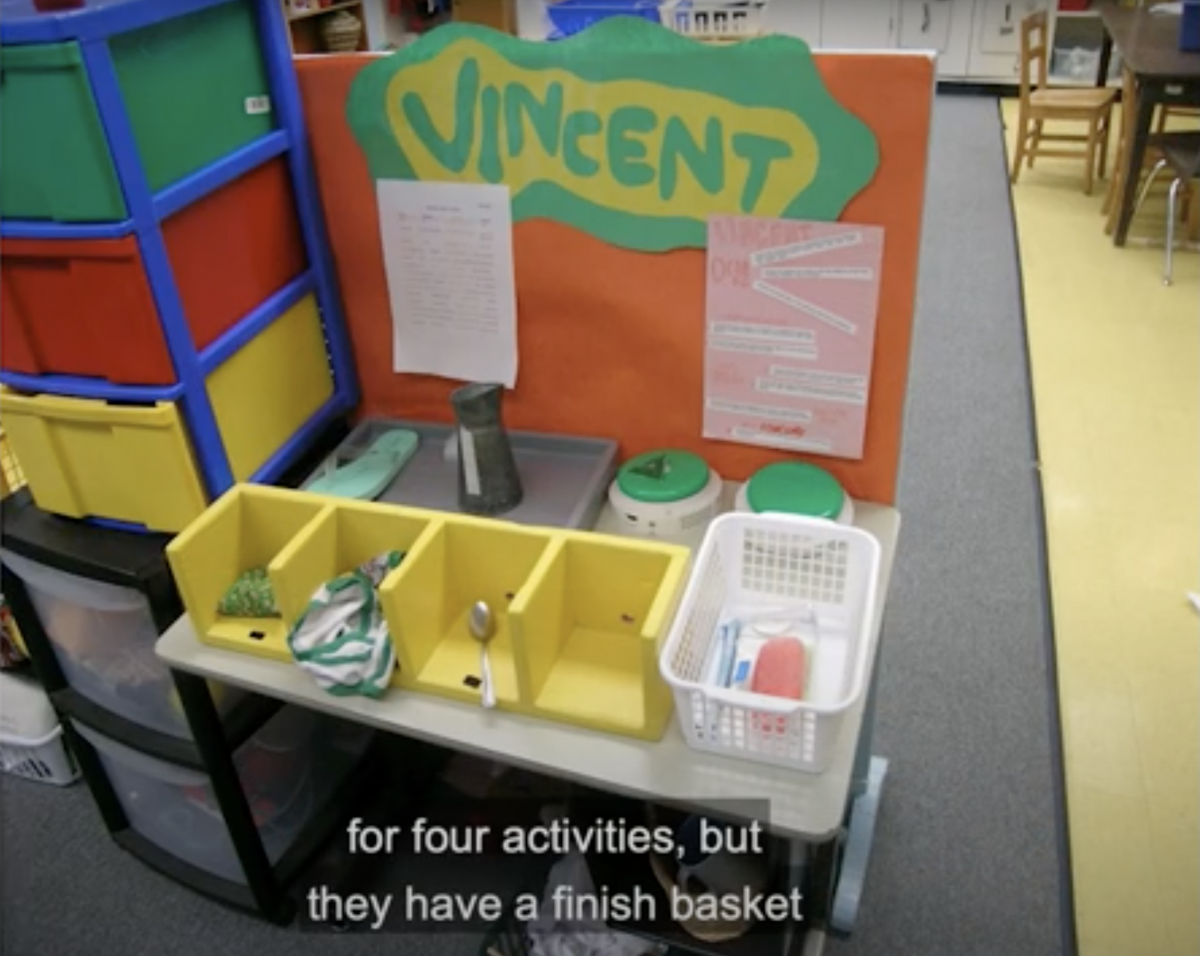
Some have flaps that may go over it. It’s individual on what you think is going to be clearest from that child’s perspective and, but you must have for every calendar a way to show future and past. On some calendars we put an x when it’s finished and anything without an x is waiting to happen. You might on a monthly calendar have x’s on what’s done. You have a square on today and the future’s blank. It just needs to be clear enough, so if the child approaches the calendar, he knows what’s done and what’s coming up.
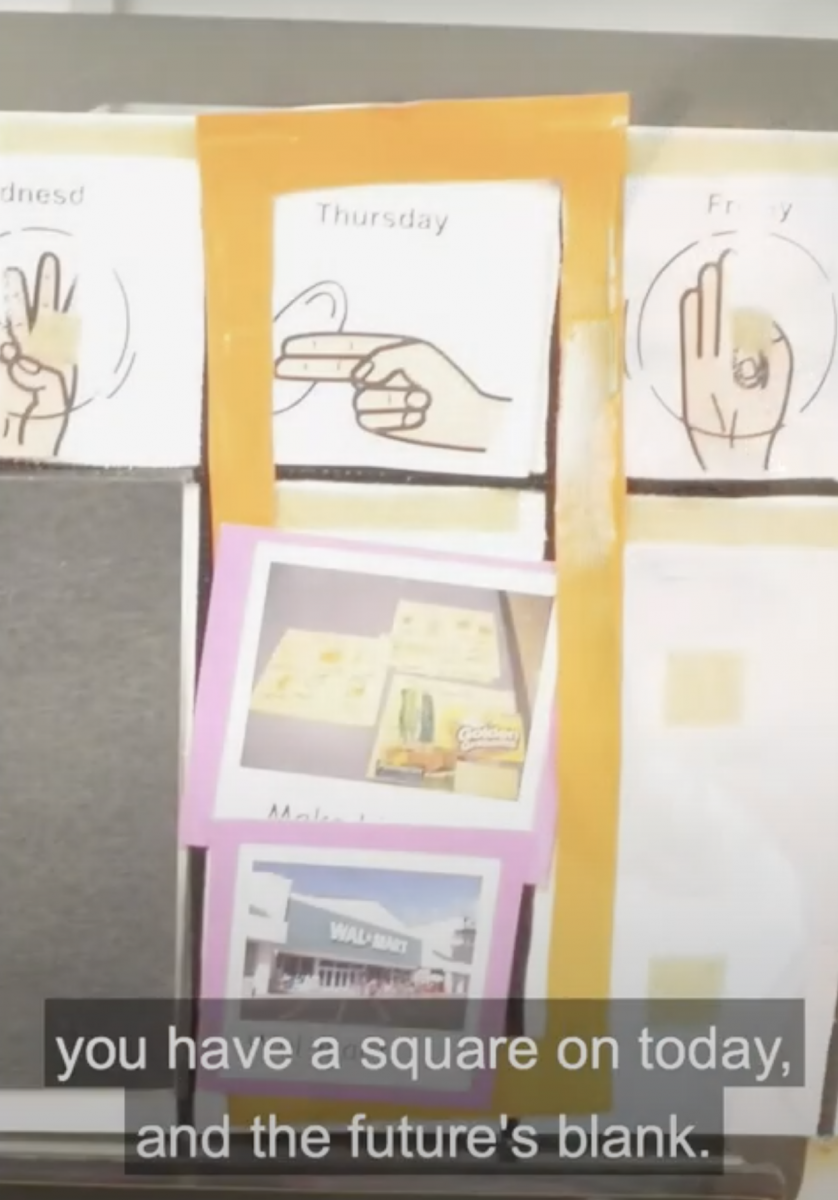
Do you have any final thoughts for parents about calendar systems?
One thing that you should always remember when you’re designing calendars is that the first one is not their forever calendar. One of the things we want to do is guide them to the time frame, so that a day calendar can become two days. You can build to a week and a week can build to the month, so the goal is always to move them further into the future and let their past extend further into the past. And the way you do that is designing time frames that have tangible chunks. They just get more of them. So it is not unusual to see kids move from a day to a week to two weeks to a month and an annual calendar in the course of their education.
All Calendars Use Their Communication Systems
But all calendars use their communication systems. All calendars have an understandable timepiece and all calendars have a way to show past and present. All calendars have time vocabulary that talk about past and present and future. I mean when you start, the first sign or the first word for future is “wait” and then they learn “later”. And then they start learning “afternoon” in the morning because that’s another future way to talk about the future. You just keep introducing more the language, more sophisticated ways to discuss the future, and sophisticated ways to talk about the past.
I think you have to have faith in the kids. It’s interesting to me how fast they learn the time vocabulary rather than nouns because i would think nouns and verbs would be easier, but Dr. van Dijk commented one time that for children and I think this is definitely true for CHARGE children; that their emotions are more concrete and tangible than objects around them in the world and addressing things like “wait” and change and giving them words in a reassuring manner, they grasp these like kids who are drowning. I mean I have always been amazed at the time vocabulary these kids pick up and I credit Dr. van Dijk with designing a system that is tangible and very on target for where they are developmentally, that’s part of a continuum so that they can keep evolving and evolving and attaching it to their emotions. I think I’ve got to take my hat off to him. It’s not the first time! I think that calendar systems are a miraculous intervention for children with CHARGE.
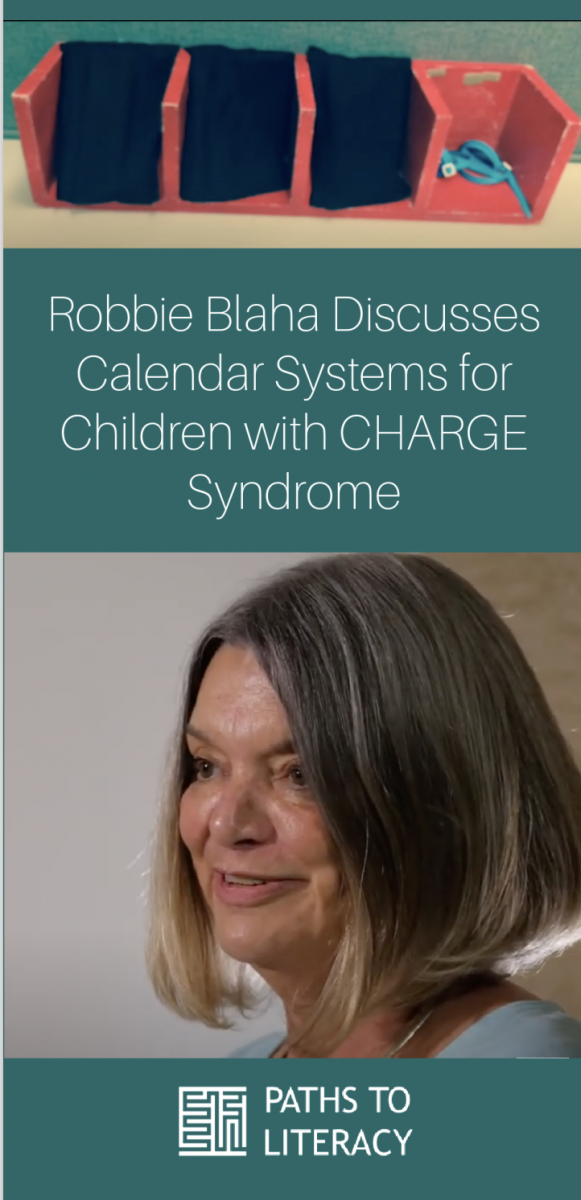
Used with permission of the CHARGE Syndrome Foundation.
